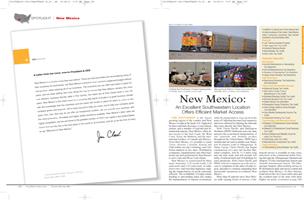
 |
Albuquerque Balloon Fiesta along the Rio Grande. Photo Courtesy of Ron Behmann |
The Southwest is the fastest growing region of the country and New Mexico is right at the heart of it. Supported by three interstate freeways, a vast railway system, and a number of regional and international airports, New Mexico offers direct access to the East Coast, the West Coast, Texas, the Midwest, and the international borders of Canada and Mexico. From New Mexico, it’s possible to reach Texas, Arizona, Colorado, Kansas and Utah within one day’s trucking, and California markets in two days. Distribution companies, manufacturers and other businesses are well-positioned in New Mexico to serve East and West Coast clients.
New Mexico is crisscrossed by three major interstates: I-25 (north-south), I-40 (east-west) and I-10 (east-west), in addition to two- and four-lane highways, making the transportation of goods extremely efficient. The availability of empty trucks heading to surrounding states also makes the transportation of exports economical, while the transportation of goods from the ports of California becomes less expensive and more efficient by utilizing the railroads that come directly into New Mexico.
Both Union Pacific and Burlington Northern (BNSF) Railroads serve the state and provide economical transportation of raw materials and finished product throughout the United States. BNSF has a multimodal rail yard available near Belen, just 30 minutes south of Albuquerque. In Santa Teresa, Union Pacific has begun construction of a new rail facility that, when complete, will be 11.5 miles long and one mile wide, and will include 200 miles of railroad track and 26 buildings for yard operations. Both Union Pacific and BNSF railroad companies provide rail access to companies in the state’s border region, and plan to continue expanding their intermodal operations in southern New Mexico.
More than 60 airports serve New Mexico with varying levels of service. Commercial service is available in nine cities, with most of the commercial traffic flowing
 |
Photo Courtesy of Lee Cohen |
through the Albuquerque International Sunport, El Paso International Airport and Amarillo International Airport. The Albuquerque Sunport offers nonstop service to 40 destinations daily and serves central and northern New Mexico. El Paso International serves the Las Cruces metro area and the southern part of the state with daily flights via seven commercial carriers. And the Amarillo International Airport is accessible from the eastern region of the state and offers daily service from three major carriers.
In addition, the recently-completed Rail Runner provides commuter access along the Rio Grande corridor from Belen through the Albuquerque metro area to Santa Fe.
New Mexico understands that its future prosperity relies upon attracting and supporting the very best companies around. The state is committed to growing strong and sustainable businesses. They have a portfolio of incentives, tax benefits and other programs that stand behind their commitment, including one of the most aggressive job training programs in the nation. New Mexico is financially stable and action-oriented to the highest levels of government, with a strong business culture and infrastructure.
Business Climate
New Mexico has one of the lowest costs of doing business of any state, and that’s just for starters. Independent research groups studied all the factors before naming the state #1 for the lowest cost of doing business. They looked at energy costs, worker compensation and taxes. Here’s what they found:
Low Energy Costs
According to the Department of Energy, New Mexico’s energy cost is 7 percent below the national average and 19 percent below the regional average.
 |
Pecan groves in southern New Mexico. Photo Courtesy of Lee Cohen |
Low Property Taxes
Today, we have the lowest property tax burden in the country, according to the Tax Foundation’s 2011 State Business Tax Climate Index. Property is assessed at only 33 percent of its market value.
Affordable Real Estate and Cost of Living
121,589 square miles makes New Mexico the fifth largest state, and that keeps the cost of real estate reasonably priced. The average price for commercial space is averaging only $18/sf for Class A and $16/sf for Class B space.
A Qualified, Productive Workforce
New Mexico offers a highly diverse, bilingual workforce. The people are motivated, skilled and well educated. In fact, the state has the highest number of PhDs per capita in the country.
Growing Fiber Network
The 12,000 mile National LambdaRail (NLR) runs right through New Mexico, both north-south and east-west. Called the “network of networks,” it gives you access to the world at the speed of light. With no restrictions on usage or bandwidth, NLR is a nationwide, advanced optical network infrastructure that can serve both the experimental needs of the high-tech and research community and the production needs of the creative community.
Incentives
To encourage companies to supply their growing markets, New Mexico’s legislature has adopted some of the country’s most aggressive business incentives. A partial list includes:
Job Training Incentives Program
Widely regarded as one of the most effective in the country, this program funds classroom and on-the-job training for newly created jobs in qualified expanding or relocating businesses for up to six months. The program reimburses a portion of employee wages. Custom training at a New Mexico public educational institution may also be covered.
High Wage Jobs Tax Credit
This credit gives companies who hire employees at salaries of $28K or higher in rural areas, and $40K or higher in urban communities, refundable tax credits equal to 10 percent of the combined salary and benefits package for the year in which the job is created, and for the three qualifying periods following.
Industrial Revenue Bonds
Communities can issue IRB’s to exempt a substantial portion of a company’s property taxes on land, buildings and equipment. IRB’s vary by community, but
 |
Outside the Southwest Cheese headquarters in Clovis. Photo Courtesy of Lee Cohen |
generally range from 50 to 95 percent for 20 to 30 years. In addition, the IRB provides a complete exemption to compensating taxes on equipment, generating approximately six percent savings.
Rural Jobs Tax Credit
Employers receive a credit of $1,000 for each qualifying job the employer creates, for four consecutive years in communities of less than 15,000 residents, and two consecutive years in non-MSA communities of more than 15,000 residents.
Manufacturer’s Investment Tax Credit
Manufacturers may take a tax credit of five percent of the value of qualified equipment and other property used in their operation. As with all these incentives, this can be stacked and provides the credit even if the tax was exempted under an IRB.
Alternative Energy Product Manufacturer’s Tax Credit
Manufacturers of photovoltaic, solar, thermal, wind, biomass and electric generation systems, electric or hybrid vehicles, and fuel cell systems may receive a tax credit of up to five percent of their capital expenses. The credit may be applied against gross receipts, compensating or withholding tax and may be carried forward for up to five years.

